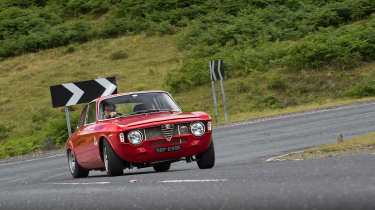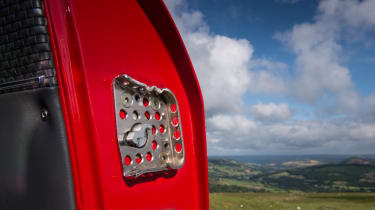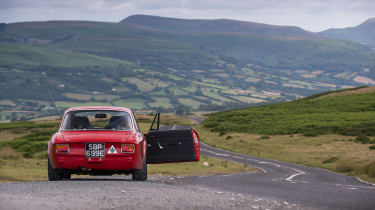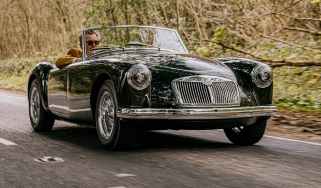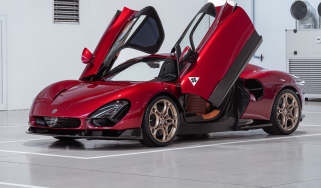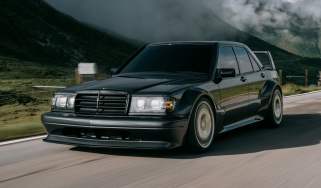Alfaholics GTA-R 270 review - Re-imagined icon - Alfaholics GTA-R 270 review - page 2
Can a 1960s Alfa GTA really justify a Ferrari-money price tag? When it's an Alfaholics GTA-R 270, it can
The limited-slip differential is a bespoke item, too. ‘It’s our own diff, which we’ve developed with copper-sintered friction plates,’ says Max. ‘This has allowed us to reduce the total preload on the diff so it hasn’t got too high a preload and becomes too noisy. It’s running with our own specification of ramp angle and we actually run no ramp during deceleration, which is why you can brake and move the car left and right and place it where you want on the way into a corner. The diff isn’t trying to hold the car straight. This car is also running two-and-a-quarter-inch springs with coilover dampers at the back, which again massively reduces all the unsprung weight.’
And then there’s the engine. ‘Under the bonnet is an Alfa 75-based Twin Spark unit,’ explains Max, ‘so it’s a proper Alfa aluminium-block, four-cylinder engine. It’s the last of the line of the true Alfa four-cylinder engines that goes back to the ’60s and is what these cars had originally. The head design is quite like the old Autodelta [competition department’s] GTA cylinder head. We build it as a 215bhp 2 litre.’
As it developed the bits for Max’s car, Alfaholics also sold them through its mail-order business. But with pictures of Max’s project being posted on the company’s website, people began asking if they could have a complete car like his GTA-R. That evolved into the business going full circle and having a workshop again, just like it had when Richard started it. Now the mail-order side and the workshop run in tandem. Most orders go abroad, with Australia and America being the biggest markets. You can order all the parts for a GTA-R in a crate and the guys reckon they ship one full kit out every couple of weeks. About 30 to 40 cars also go through the workshop, near Bristol, each year, although Alfaholics only does about two full builds in that time.
A fully built GTA-R costs – and I hope you’re sitting down for this – about £120,000. However, Max’s GTA-R has evolved a step further and for £198,000 Alfaholics will now build you a car like the one you see here, which is even lighter and even more powerful, with custom parts that can’t be purchased separately. For starters there is a carbonfibre bootlid, bonnet and doors. The front wishbones are made from titanium, as are the wheel nuts and wheel bolts. Everything that can be machined from billet aluminium has been and there are some parts that have more holes than a Polo factory.
The end result is a kerb weight of 835kg – a reduction of 80kg over a ‘normal’ GTA-R – and that’s with the leather and Wilton wool carpet still in the car. This car is what they’re calling the ‘GTA-R 270’ (for 270bhp/ton), but there is also a 290 version coming with a 2.3-litre engine that has a long-stroke crank, a bigger bore and a special sort of closed-in deck to stiffen the block up. In theory that is a 240bhp engine, with a leap in torque from 160lb ft up to 200lb ft. The GTA-R 290 will set you back £222,000, which is a hell of a lot of money, but as the Banks brothers are at pains to explain, this represents the amount of time that goes into each one.
I have to say that, walking up to the car, I am already rather smitten. There is that slightly odd proportion to cars like this and the Ford Escort that doesn’t look quite right from some angles, with the glasshouse appearing too long, but then the aesthetic is just perfect from others. The rear arches look cool but curiously unfinished compared to the rest of the car, but that’s how they were on the original Autodelta design. There is no need for me to write reams on the beautifully drilled parts as you can lust after them yourself through the photos. However, I will just mention that after you’ve pulled open the door with the teeny-tiny handle, you can’t help but notice that even the door closing plates have been holed like they’ve had close-quarters contact with the wrong end of an Uzi.
Inside, the car looks like new. But better. The leather covering the Recaro buckets is woven in places to mimic that of the original seats, the carpet is thick and luxurious, and the pedals are machined from billet aluminium by the same company that does the dash in a Bugatti and the drinks cabinet in a Rolls-Royce. In fact, all the pieces such as the door handles and window winders have been machined from billet to save weight, before being polished so that you wouldn’t know they weren’t the chromed originals. Although you cannot use them because of the lightweight (but leather covered) T45 cage that has been welded in, retaining the seats in the back is the final element that makes this feel like a very habitable car indeed.

